

The Devonport Regional Gallery's Art Lab 2008 program is an innovative education package designed to push the boundaries of a regional gallery's role within the local community and education. The extensive seven month project connected teenage students from different schools with the media, general public and the gallery. Art Lab 2008 was summarised by a two week exhibition displaying the diverse outcomes from the project.
All projects were designed to be team based and student-lead to create tangible outcomes that resemble real world products produced in dynamic professions. Situated in the centre of each program was the discussion of art, deepening their understanding of the subject.
Art Lab received funding assistance from the Lighthouse Can Do Will Do Project. This early intervention initiative is designed to equip young 'at-risk' people and young offenders in the Mersey region with role models and mentors who will help provide them with knowledge, skills and attitudes to be successful in life. The project delivers diverse community based activities to young people within their community through the fostering of ownership, community pride, connectedness and relationships.
ART LAB 2008: THE EXHIBITION, Catalogue
 |  |
| Director of Community Services Evonne | People listening to the podcasts at the exhibition |
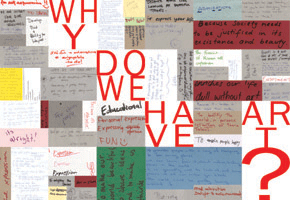 |  |
| Inside of the pamphlet made by students on display | Still from Graffiti film made by students on display |
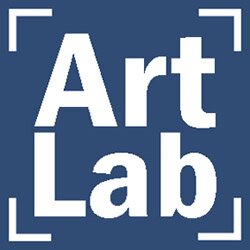
Art Lab 2008 is an innovative education package initiated by the Devonport Regional Gallery. This pioneering project was aimed to create new boundaries for a regional gallery's role within the local community and education.
The three projects were UR Say, Ask It and Shoot. Students in year 9 and 10 in the four local surrounding high schools where invited to participate. There was no charge to schools or students and a pick up and drop off service was made available. Projects were designed to be student-led to create products that resemble real-world and dynamic professions including design, filmmaking, radio and written journalism. Situated in the centre of the project framework was the discussion of cotemporary art deepening their understanding of an often intimidating subject. More information about each project is detailed in the table below.
Art Lab 2008 was structured to be inclusive to a wider community of students unlike many traditionally-designed subject specific programs. With the concentration on the development of skills translatable to other areas, this program posed the opportunity for students to be exposed to contemporary art which may be a field they had not previously engaged in. Teachers were urged to look beyond the art class and it was recommended for those who may need a boost of self-esteem or re-engagement in learning.
To complete the program the Devonport Regional Gallery presented a graduation ceremony at the opening of the two week show Art Lab 2008: The Exhibition. Students received the Art Lab 2008 ‘package' made up of the exhibition catalogue, a copy of all the work on display, a certificate and a year membership which will help continue their connection to the gallery. The exhibition featured students' responses to Art Lab 2008, photographs taken during the programs and the project's final outcomes including short films, a coffee table book compiled from public responses to the question ‘what is art?', a fold-out pamphlet and series of posters responding to the question ‘why do we have art?'; a journal featuring clippings from the reviews published in the Devonport Times written by participating students, and podcast's of the students delivering radio reviews of art exhibitions on Coast FM Wynyard and Edge Radio, Hobart.
A multifaceted project of this magnitude involving a number of stakeholders has achieved many results beyond the tangible objects displayed in the exhibition. While promoting cultural growth in the community, the tutors of Art Lab 2008 have witnessed significant personal development in the participant's health and well being, as well as their understanding and comfort in approaching contemporary art, and being in a gallery space. The local community has also been brought together through the program and seen friendships created between individuals as well as connections strengthened between different groups and organisations. The real-world element in the education structure provided students with an insight to many dynamic careers such as graphic design, market research, radio and newspaper journalism, and various roles in film making, for a regional area which is predominantly transport and primary industries.
The Devonport Regional Gallery received financial assistance from the Lighthouse Can Do Will Do Project. This is an early intervention initiative that equips young 'at-risk' people and young offenders in the Mersey region with role models and mentors who will help provide them with knowledge, skills and attitudes to be successful in life. The project delivers diverse community based activities to re-engage young people with their community through the fostering of ownership, community pride, connectedness and relationships.
For more information about the lighthouse project visit:
http://www.devonport.tas.gov.au/index.php?option=com_content&task=view&id=183&Itemid=198
| UR SAY |
| Project Objective: Student art reviews for radio and newspaper |
| Tutors: Josie Hurst and Vicky Xypteras |
| March - May Participants: Ethan Barron, Joey Clarke, Georgia Elliott, Samantha Ewins and Kyle Hind |
| July - September Participants: Lucy Knowles, Taylor Murphey and Teneille Tress |
UR Say was designed to provide a platform for students to discuss and review visual art for either the radio or newspaper. This deepened their understanding of visual art while focusing on developing communication techniques and learning the fundamentals of journalism. Students worked as a team to discuss and evaluate exhibitions at galleries in Devonport, Burnie and Hobart. Exhibition reviews were then workshopped for publication in the Devonport Times or airing on Wynyard's Coast FM.
This program worked towards the highlight of a three-day trip to Hobart with the challenge of writing a review about numerous exhibitions in Hobart or to present one live on Edge Radio. The students visited several galleries including Carnegie Gallery, Tasmanian Museum and Art Gallery, Long Gallery, Plimsoll, CAST and artist run initiatives 6a and Inflight. From the contemporary to the traditional, an enormous variety of artwork was seen including photographs, drawing, graffiti-style works, installation, printmaking, sculpture, video and painting.
Students were encouraged to consider the exhibitions as a whole, learning about the role of a curator and how the different galleries vary in purpose and style. Throughout the program students were introduced to a number of art professionals: gallery directors, artists, curators, gallery staff and art critics giving them a unique perspective of the operations in a gallery environment.
UR Say worked with contemporary visual art more directly than the other programs in the Art Lab 2008 program. Students were presented with new challenges which they took on with enthusiasm and gusto, producing reviews far exceeding original expectations. In many ways UR Say was an art appreciation class but the production of reviews gave it an objective with a real-world feel. It provided a fantastic outlet for the students to express their personal opinions and then communicate them to the wider community.
 | 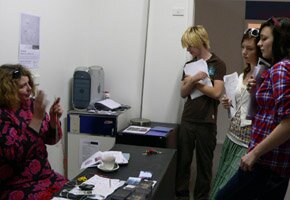 |
| UR SAY class at the North Hobart ARI 6a. Back: (L-R) Beth O'Loughlin, Georgia Elliott, Samantha Ewins, Ethan Barron, Artist Tim Clarke Front: Josie Hurst, Vicky Xypteras and Joey Clarke | Meeting artist Sally Rees at North Hobart ARI Inflight (L-R) Sally Rees, Joey Clarke, Samantha Ewins and Georgia Elliott, |
 |  |
| Talking Live on Arts on Edge, Edge Radio Hobart. (L-R) Josie Hurst, Georgia Elliott and arts presenter Shauna Mayben Swanson | Look at artwork at Carnegie Gallery, Hobart |
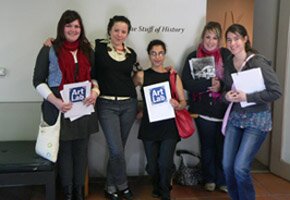 |  |
| UR Say group at Plimsoll Gallery Teneille Tress, Josie Hurst, Vicky Xypteras, Taylor Murphey and Lucy Knowles | UR Say group at CAST Gallery Vicky Xypteras, Josie Hurst, Lucy Knowles Teneille Tress and Taylor Murphey |
 |  |
| Talking Live on Arts on Edge, Edge Radio Hobart. (L-R) Teneille Tress and presenter Wayne Brookes | UR Say group at Edge Radio Hobart. (L-R) Radio Presenters: Wayne Brookes and Matt Ward Teneille Tress, Taylor Murphey Lucy Knowles and Vicky Xypteras |
| SHOOT |
| Tutors: Josie Hurst and Telen Rodwell |
| Project Objective: Short films using the moving image and stop motion |
| May Shoot Class Participants: Jesse Connors, Devin Heger, Tama Rakei and Jabin Shaw |
| July Shoot Class Participants: Timothy Kariotis, Danny Smith, Helen Treloar, Kathryn Whiteley and Cody Williams |
Shoot challenged students to identify an element of visual art within the community and explore their chosen idea through the medium of film. This was an intensive four-day project where students learnt fundamental filmmaking skills including storyboarding, scriptwriting, character development, capturing footage and editing.
In groups of two students made either two short films; one is using the moving image and the other uses the static image; or one longer film that contained both elements. Students generated the static using a number of methods including photographs, drawing, collage or scanning a variety of materials and are introduced to the beginnings of animation possibilities.
 |  |
| Shoot class Back: (L-R) Devin Heger, Tama Rakei, Jesse Connors and Jabin Shaw Front: Telen Rodwell and Josie Hurst | Editing the films in Shoot class. Josie Hurst, Jesse Connors and Tama Rakei, |
 | 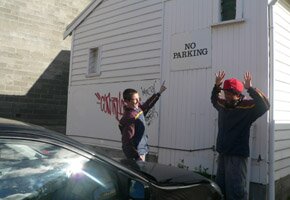 |
| Still from shoot video Graffiti by: Jesse Connors and Tama Rakei | Posing for stop motion animation about all the 'no signs' in Devonport. Jesse Connors and Tama Rakei |
 | 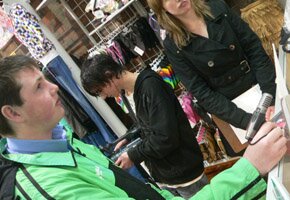 |
| Still from shoot video Freedom by: Helen Treloar and Timothy Kariotis | Shoot participants Cody Williams, Danny Smith, and Kathryn Whiteley |
 |  |
| Shoot participants Timothy Kariotis and Helen Treloar | Still from shoot video Shoot News Kathryn Whiteley and Telen Rodwell |
| ASK IT |
| Tutors: Josie Hurst and Vicky Xypteras |
| Project Objective: Book publication |
| May Ask It Class Participants: Julia Andrew, Lauren Boyd, Ashleigh Brundritt, Abbie Davis, Samantha French, Anna Martin, Tamika Mclaren and Allan Nesbitt |
| August Ask It Class Participants: Anna Brain, Kate Beveridge, Amelia Davenport, Sarah Shaw, Joseph Turnbull and Matthew Smith |
Ask It was an active four-day program which ran twice throughout the year. Students worked as a team to produce either a book or pamphlet and posters responding to a philosophical question about art. Using a number of team-based exercises and brain storming the students led the project deciding how to collate a response from the public. Once their answers were gathered the students then chose the ‘look and feel' and designed the layout of their publications.
What is art? Think you know the answer? This question can be more difficult to answer than first appears. As the first Ask It group discovered, peoples' responses can vary as far as your imagination can take you. The students devised a number of creative ways to collect a response from the Devonport public. With a display in the Rooke Street Mall they encouraged people to reply to the question using playdough, paint, pencils and collage. They also photographed their surroundings in response to vox pops, negotiated with cafe owners to attach butcher's paper to their tables inviting anonymous replies, drew chalk murals on the pavements with a yes/no tally and dressed up as ‘Art Angels' for people to respond by writing on their calico costume. Students also made personal responses ranging from wordy descriptions to collages or drawings. The vibrant collection of answers has been made into a small print publication balancing the deep and philosophical reflections with other more comical and whimsical answers.
Why do we have art? This question can make us stop and ponder art's purpose and in reverse what a world without art could be like. The second Ask It group was presented with the challenge to create a response in the form of a foldout pamphlet and 7 A1 posters to be displayed in the exhibition. With a more text-based response than the previous group this team of students decided to ask the public in the mall to submit a written response. They also distributed response-boxes at the library, shops and cafes. The replies were then categorised into emerging themes: the jovial, philosophical, the apathetic and the classic line of, ‘I don't know'. Students worked busily to respond to the text and create a dynamic visual display.
 |  |
| ASK IT class, workshoping ideas (L-R) Julia Andrew, Lauren Boy, Ashleigh Brundritt Tamika McLaren, Anna Martin, Abbie Davis and Allan Nesbitt | ASK IT class, building the display material (L-R)Samantha French, Julia Andrew and Allan Nesbitt |
 |  |
| ASK IT paticipant Allan Nesbitt discussing his street chalk mural with a member of the public | The May ASK IT group with the stall in the Rooke St. mall Back: (L-R) Lauren Boy, Abbie Davis, Allan Nesbitt, Samantha French, Tamika McLaren, Ashleigh Brundritt, Anna Martin and Vicky Xypteras. Front: Josie Hurst and Julia Andrew |
 |  |
| Getting a response from a member of the public Particpants (L-R): | ASK IT paticipant Allan Nesbitt discussing his street chalk mural with a member of the public |
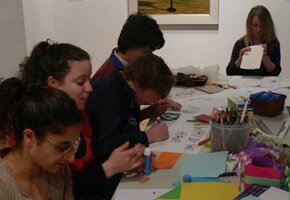 |  |
| Preparing for the display (L-R) Vicky Xypteras, Josie Hurst, Matthew Smith, Joseph Turnbull and Sarah Shaw | The August Ask It group with their display in the |
The Devonport Regional Gallery would like to thank the schools that participated in the Art Lab program development - Latrobe High School, Reece High School, Devonport High School and St. Brendan-Shaw College. In particular a special appreciation goes to the teachers that helped make the project possible: Emma Harris, David Keen, Warwick Campbell, Cindy Johnston, Helen Smialek, Pauline Dittmann and Donna Lougher and Principals Sheree Vertigan, Philip McKenzie, Frank Rice and Mandy Reynolds-Smith.
The project tutors Josie Hurst, Vicky Xypteras and Telen Rodwell worked tirelessly with strong support and guidance from Gallery staff members Jane Stewart, Ellie Ray, Angela Barrington, Kim Prunster and Georgia Hyde. Extended gratitude for the generous financial assistance that made the concept of this project a reality goes to The Lighthouse Can Do Will Do Project led by Charmane Sheehan and Carol Bryant. Acknowledgment is given to the Devonport City Council and the Director of Community Services Evonne Ewins for realising the scope of the innovative project and providing their full support.
We acknowledge the kind assistance of the media who published the students work from the UR Say project - Devonport Times, Coast FM, Edge Radio, Arts on Edge Program and Apple. A big thankyou goes to the staff at these organisations who enthusiastically provided not just the essential resource, but shared their time and professional knowledge - Kate Jowett, Rochelle Galloway, Karin Broady, Brett Salter, Mel Page, Shauna Mayben Swanson, Matt Ward, Wayne Brooks and Kelly Eijdenberg
Students from the UR Say project visited a variety of Galleries - Burnie Regional Gallery, CAST, Plimsoll, Tasmanian Museum and Art Gallery, Carnegie, Inflight, 6a, the Long Gallery and Salamanca Collection. We extend our gratitude to the following gallery staff, artists and curators who greeted students at these galleries sharing their time and knowledge, and providing great insight into the work and their roles in the industry - Greg Leong, Randoph Wylie, Sue Backhouse, Rob O'Conner, Tim Clarke, Sally Rees, Michael Edwards, Kit Hiller, Andrew Olivier and Chen Ping.
Thank you also goes to Ted Field and The Devonport State Library, The Devonport Book Shop, The Larder Café and the many people in the Devonport community who participated in the various films and vox pops.
Lastly but most importantly the biggest thanks goes with congratulations to the participating students for their enthusiasm, hard work and creativity.
|
| |
| Art Lab 2008: The Exhibition, Catalogue | |
| Ask It book made by students Open | |
| Ask It pamphlet made by students Why do we have art? | |
|
|